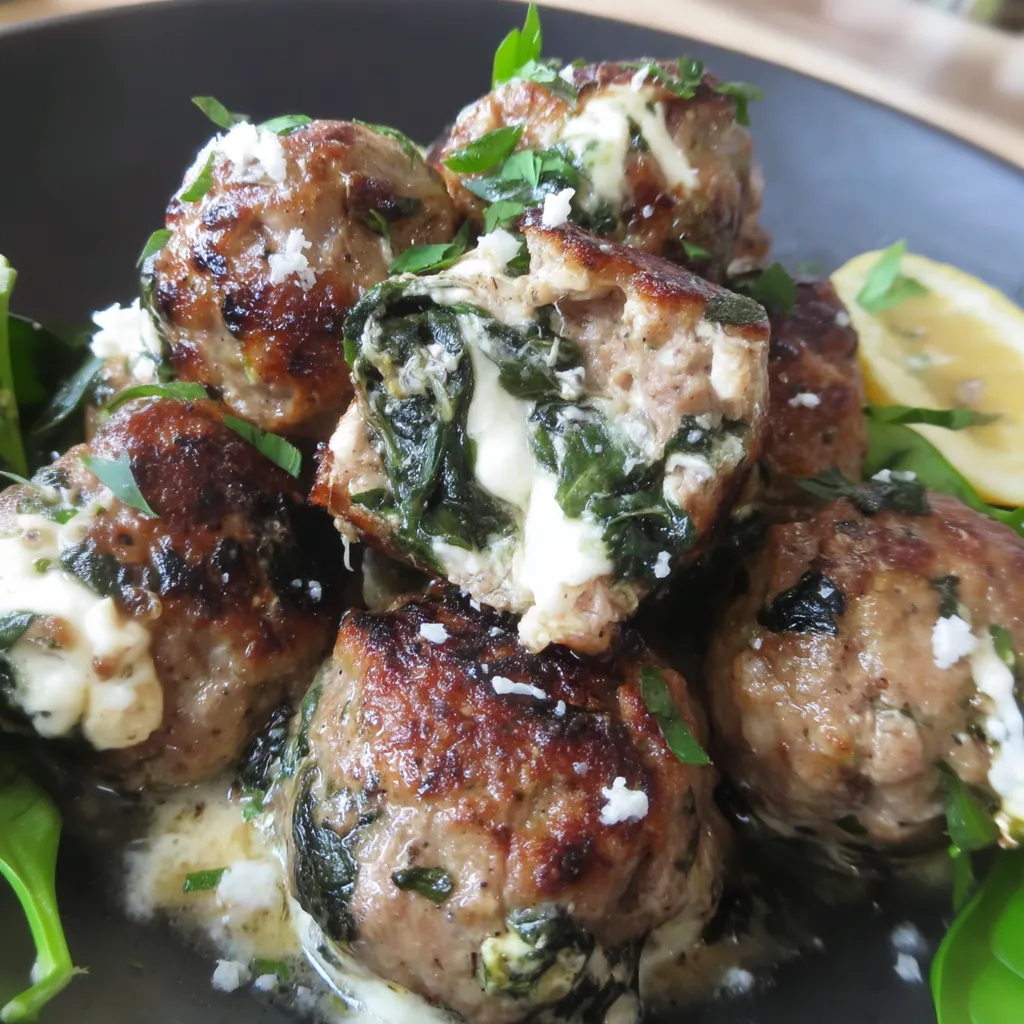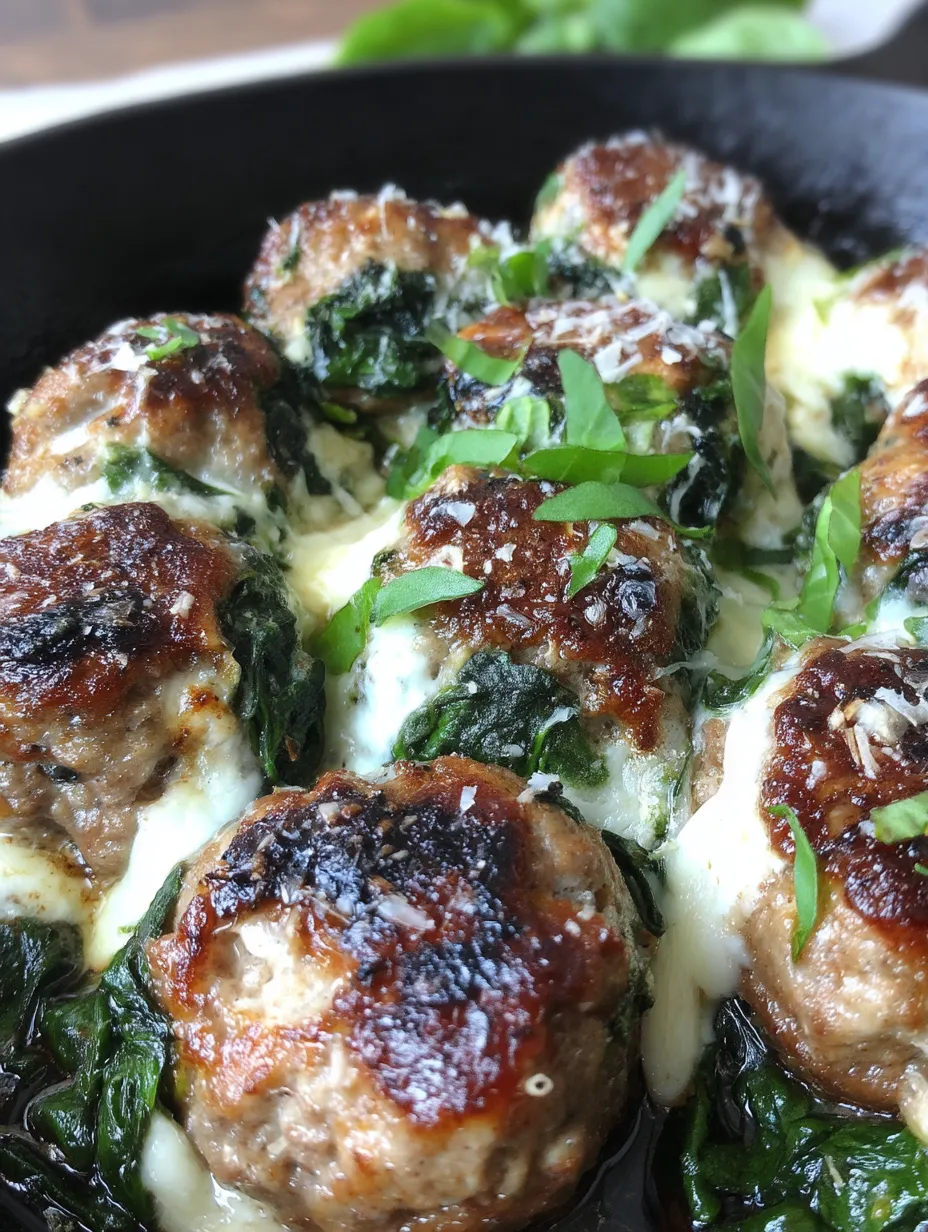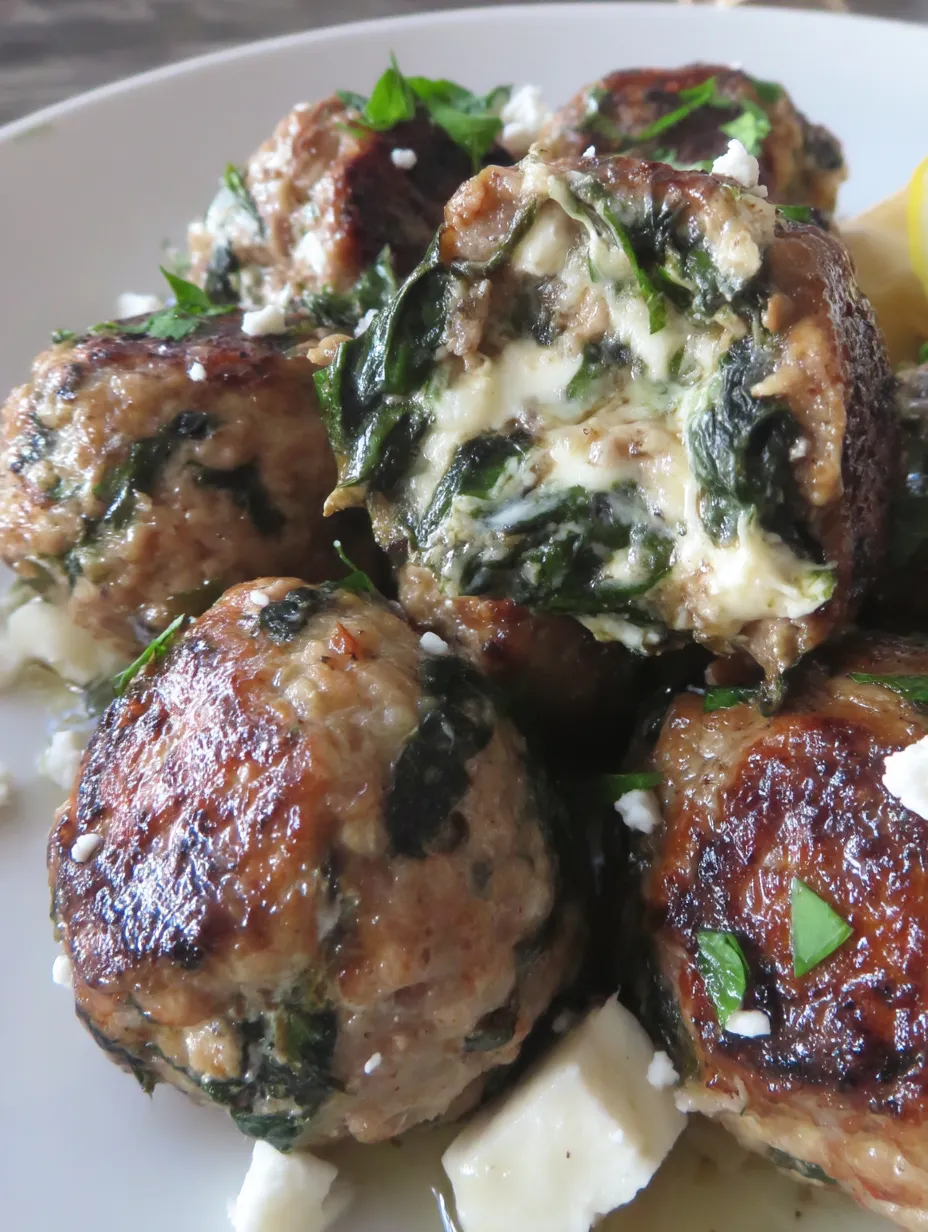 Pin it
Pin it
Nothing transforms a simple pasta night into something special quite like homemade meatballs. These spinach garlic meatballs take things to the next level with a surprise inside – a melty pocket of mozzarella that creates that perfect cheese pull when you cut into them. I started making these for Sunday family dinners, and they've become the meal everyone requests when they come home to visit.
Last Christmas, my brother in law who rarely comments on food actually stopped mid bite, looked at his plate with wide eyes, and asked "How did you get the cheese in there?" Sometimes the simplest cooking tricks create the biggest impressions!
Key Ingredients
- Mixed Meats: The combination of beef and pork creates the perfect flavor and fat balance—all beef can be too dry, all pork too soft
- Fresh Spinach: Adds moisture, nutrition, and beautiful flecks of green—wilting it first concentrates the flavor and reduces volume
- Garlic Two Ways: Both in the spinach mixture and the meat mixture for layered flavor—fresh makes all the difference here
- Quality Parmesan: Brings savory depth that elevates the entire meatball—freshly grated has far better flavor than pre grated
- Mozzarella Cubes: The secret surprise that makes these meatballs memorable—cutting them small ensures they're properly surrounded by meat
I discovered the magic of the beef pork combination after several batches of meatballs that were either too dry or didn't hold their shape. That 50/50 blend creates the perfect balance of flavor, fat, and texture. Sometimes the simplest tweaks make the biggest improvement in a recipe.
 Pin it
Pin it
Step-by-Step Instructions
- Spinach Preparation
- Taking the time to wilt the spinach properly concentrates its flavor while removing excess moisture that could make the meatballs soggy. Adding the garlic toward the end prevents it from burning and becoming bitter. That fine chopping ensures the spinach distributes evenly throughout the meat mixture without creating large gaps.
- Perfect Meat Mixture
- Combining all ingredients thoroughly but gently prevents tough meatballs. The splash of milk might seem unusual, but it adds moisture and helps bind everything together. Those breadcrumbs might seem like a lot, but they're necessary for structure, especially with the cheese inside. Proper seasoning at this stage is crucial—the salt and pepper should be generous as they'll flavor a large amount of meat.
- Cheese Stuffing Strategy
- The key to successful cheese stuffed meatballs is completely enclosing the cheese. Taking a portion of meat mixture, flattening it slightly, placing the cheese cube in the center, then folding the meat around it and rolling gently between your palms creates a perfect seal. If the cheese peeks through at all, it will leak out during cooking.
- Two Step Cooking
- That initial pan searing creates a flavorful crust that adds depth to the final dish. The cast iron retains heat beautifully, helping the meatballs cook evenly. Transferring to the oven allows them to finish cooking gently without burning the outsides. The sauce dollops in the pan not only prevent sticking but also begin to create the sauce that will coat your pasta.
- Temperature Testing
- Using a meat thermometer to check for doneness 165°F ensures your meatballs are food safe without overcooking. Different sized meatballs will cook at different rates, so checking the largest ones gives you the best gauge for doneness. That foil covering prevents the tops from drying out while allowing everything to heat evenly.
My first attempt at cheese stuffed meatballs was a disaster – the cheese leaked out and burned on the bottom of the pan because I didn't properly seal the meat around it. I've since learned that taking that extra minute to carefully enclose each cheese cube makes all the difference between picture perfect meatballs and a messy though still delicious situation.
Serving Style
These meatballs shine when served over pasta with additional warmed marinara. For a lighter option, pair them with zucchini noodles or spaghetti squash. They also make incredible meatball subs – just slice them in half lengthwise, place on toasted hoagie rolls, top with extra sauce and cheese, and broil until bubbly. For appetizers, make them bite sized and serve with toothpicks alongside warm marinara for dipping.
Creative Variations
Transform this basic recipe with simple switches that create entirely new flavor experiences. Try ground turkey instead of beef and pork for a lighter version, adding a tablespoon of olive oil for richness. Swap the spinach for chopped fresh basil and the mozzarella for a cube of fontina for an Italian herb variation. Add a pinch of red pepper flakes to the meat mixture for subtle heat throughout. For a Greek inspired version, use feta instead of mozzarella and add some chopped fresh dill to the spinach mixture.
Make Ahead Magic
These meatballs are perfect for batch cooking and freezing. Form them completely, including the cheese stuffing, then freeze them on a baking sheet until solid. Transfer to freezer bags where they'll keep for up to three months. To cook from frozen, add about 10 15 minutes to the oven time. Alternatively, you can fully cook them, cool completely, and freeze in their sauce for ready to heat meals. The fully cooked meatballs also keep well in the refrigerator for 3 4 days in an airtight container.
 Pin it
Pin it
I've been refining this recipe for nearly five years now, gradually perfecting the meat to breadcrumb ratio and cooking technique. What started as an attempt to sneak more vegetables into my family's diet has become one of our most requested special occasion meals. There's something deeply satisfying about watching someone cut into a meatball and experience that moment of surprise when they discover the melty cheese center – a small culinary magic trick that never fails to delight.
Frequently Asked Questions
- → Can I make these meatballs ahead of time?
- Yes! You can form the meatballs and refrigerate them covered for up to 24 hours before cooking, or freeze raw meatballs for up to 3 months.
- → What can I use instead of ground pork?
- Ground turkey, chicken or more ground beef all work great as substitutes for the pork. Just keep the total amount of meat the same.
- → Do I need to use fresh spinach?
- Frozen spinach works too. Thaw it completely, squeeze out ALL excess moisture, and use about 10 oz frozen spinach to replace the fresh.
- → Can I make these without breadcrumbs?
- For a gluten-free version, use gluten-free breadcrumbs or crushed pork rinds. You can also use cooked and cooled quinoa or rice as a binder.
- → What's the best way to serve these meatballs?
- They're classic over spaghetti, but also delicious with crusty bread for dipping, on top of polenta, or as a hearty sub sandwich filling.
- → How do I know when the meatballs are done?
- The safest way is to use a meat thermometer - they should reach 165°F in the center. If you don't have one, cut a meatball open - the meat should be no longer pink inside.
